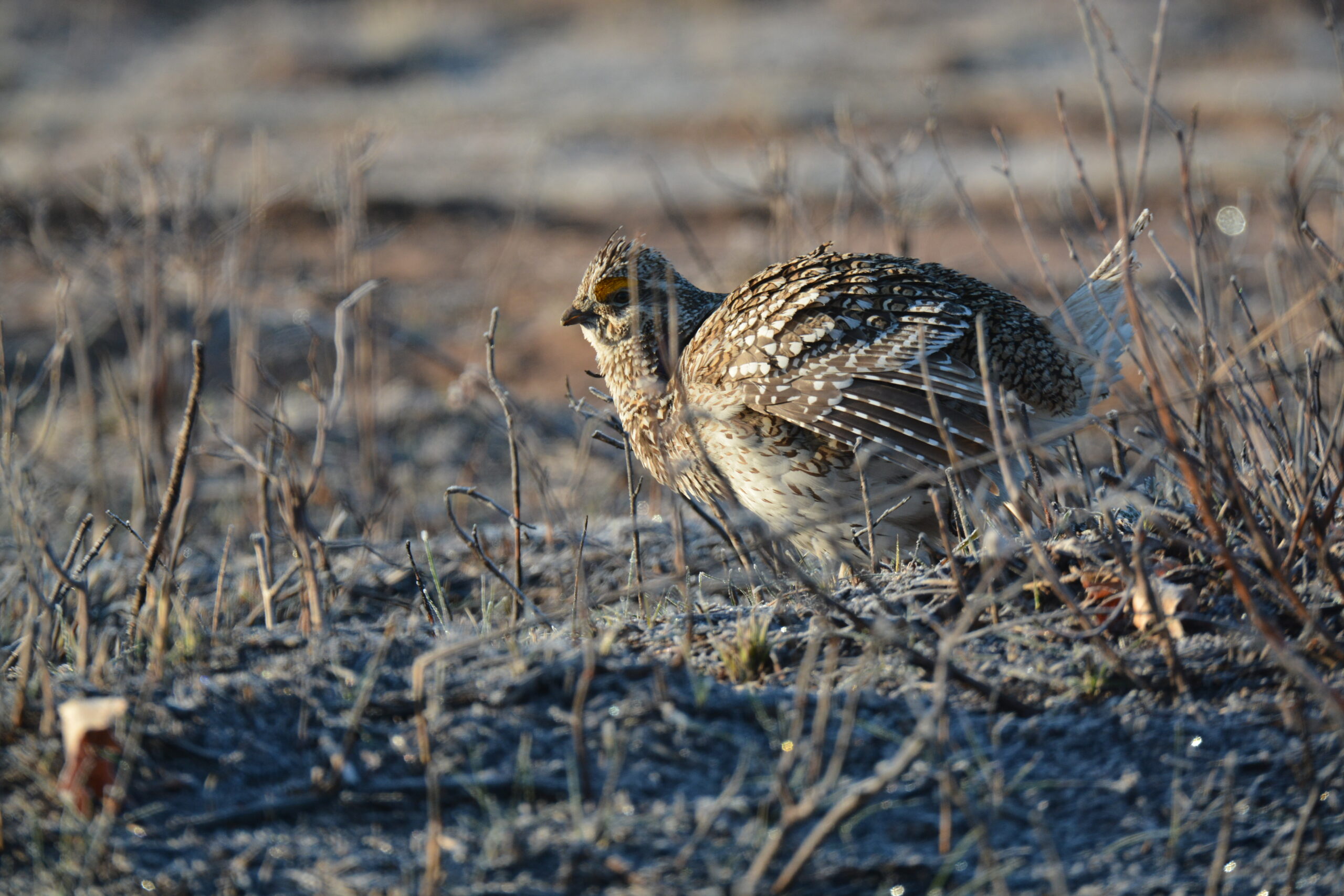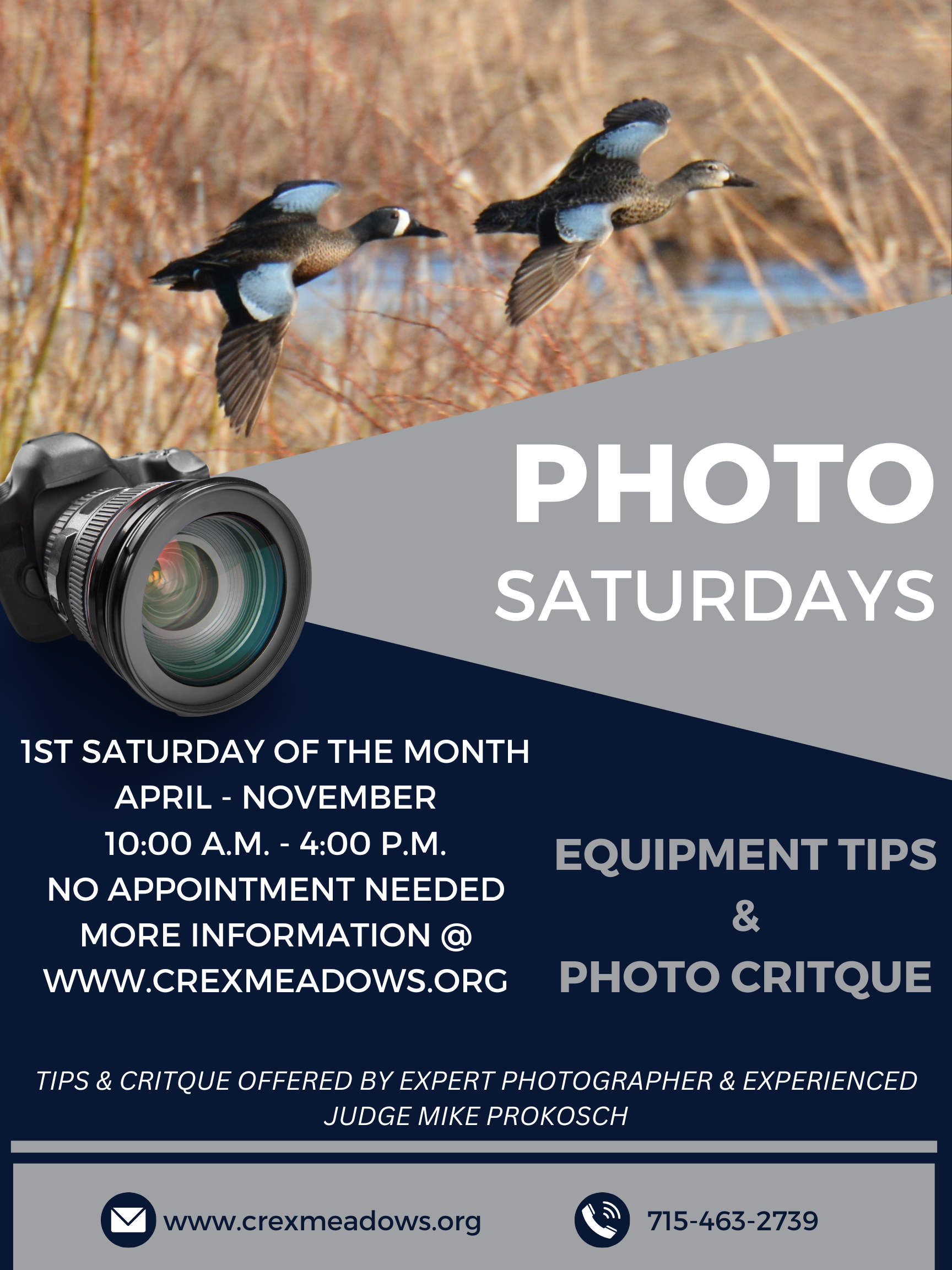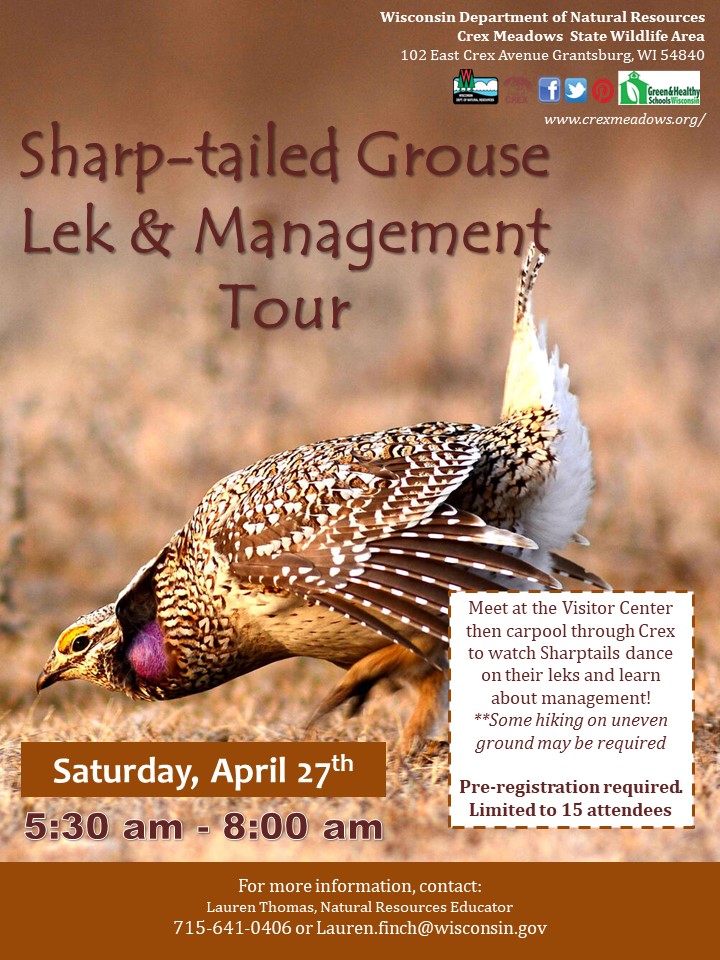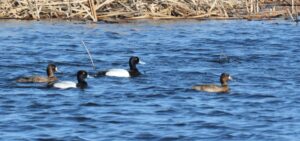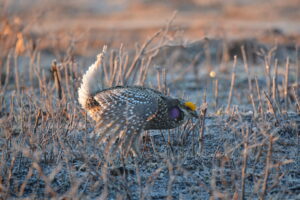Calendar of Events
S Sun
M Mon
T Tue
W Wed
T Thu
F Fri
S Sat
0 events,
0 events,
0 events,
0 events,
0 events,
2 events,
Sharp-tailed Grouse Viewing Blinds
Sharp-tailed Grouse Viewing Blinds
Want to get up close and personal with sharp-tailed grouse? This is your chance! Once again, we are happy to offer viewing blinds at Crex Meadows this spring. There are…
FOC Member Exclusive – Morning Coffee Social
FOC Member Exclusive – Morning Coffee Social
Gather with other Friends of Crex members on the first Friday of each month from 7:30am to 9:00am. Enjoy a cup of coffee on us and share your stories about…
2 events,
Sharp-tailed Grouse Viewing Blinds
Sharp-tailed Grouse Viewing Blinds
Want to get up close and personal with sharp-tailed grouse? This is your chance! Once again, we are happy to offer viewing blinds at Crex Meadows this spring. There are…
Photo Saturdays
Photo Saturdays
The Friends of Crex invites photographers to stop in at the Crex Meadows Wildlife Area Visitor Center this year to receive photo critique and equipment tips. Mike Prokosch, an expert…
1 event,
Sharp-tailed Grouse Viewing Blinds
Sharp-tailed Grouse Viewing Blinds
Want to get up close and personal with sharp-tailed grouse? This is your chance! Once again, we are happy to offer viewing blinds at Crex Meadows this spring. There are…
0 events,
0 events,
0 events,
0 events,
1 event,
Sharp-tailed Grouse Viewing Blinds
Sharp-tailed Grouse Viewing Blinds
Want to get up close and personal with sharp-tailed grouse? This is your chance! Once again, we are happy to offer viewing blinds at Crex Meadows this spring. There are…
1 event,
Sharp-tailed Grouse Viewing Blinds
Sharp-tailed Grouse Viewing Blinds
Want to get up close and personal with sharp-tailed grouse? This is your chance! Once again, we are happy to offer viewing blinds at Crex Meadows this spring. There are…
1 event,
Sharp-tailed Grouse Viewing Blinds
Sharp-tailed Grouse Viewing Blinds
Want to get up close and personal with sharp-tailed grouse? This is your chance! Once again, we are happy to offer viewing blinds at Crex Meadows this spring. There are…
0 events,
0 events,
1 event,
Grantsburg Library Program
Grantsburg Library Program
Join Wildlife Educator, Lauren Finch, at the Grantsburg Public Library for wildlife stories, crafts, lessons, and more!
0 events,
1 event,
Sharp-tailed Grouse Viewing Blinds
Sharp-tailed Grouse Viewing Blinds
Want to get up close and personal with sharp-tailed grouse? This is your chance! Once again, we are happy to offer viewing blinds at Crex Meadows this spring. There are…
2 events,
Sharp-tailed Grouse Viewing Blinds
Sharp-tailed Grouse Viewing Blinds
Want to get up close and personal with sharp-tailed grouse? This is your chance! Once again, we are happy to offer viewing blinds at Crex Meadows this spring. There are…
Earth Day Property Clean-up
Earth Day Property Clean-up
Join us for a spring property clean-up to celebrate Earth Day! Check-in at the visitor center at 8:00 a.m. to get your route for roadway/trail clean-up. Over the next several…
1 event,
Sharp-tailed Grouse Viewing Blinds
Sharp-tailed Grouse Viewing Blinds
Want to get up close and personal with sharp-tailed grouse? This is your chance! Once again, we are happy to offer viewing blinds at Crex Meadows this spring. There are…
0 events,
0 events,
1 event,
Nature Book Club
Nature Book Club
Join us virtually or in person for a nature-themed book club! Ticket sales close 6 weeks before the meeting. You only need to purchase a ticket if you need a…
0 events,
1 event,
Sharp-tailed Grouse Viewing Blinds
Sharp-tailed Grouse Viewing Blinds
Want to get up close and personal with sharp-tailed grouse? This is your chance! Once again, we are happy to offer viewing blinds at Crex Meadows this spring. There are…
2 events,
Sharp-tailed Grouse Viewing Blinds
Sharp-tailed Grouse Viewing Blinds
Want to get up close and personal with sharp-tailed grouse? This is your chance! Once again, we are happy to offer viewing blinds at Crex Meadows this spring. There are…
Sharp-tailed Grouse Lek & Management Tour
Sharp-tailed Grouse Lek & Management Tour
Meet at the visitor center then carpool through Crex to watch sharp-tailed grouse dance on their leks and learn about management! Some hiking on uneven ground may be required. RSVPs…
1 event,
Sharp-tailed Grouse Viewing Blinds
Sharp-tailed Grouse Viewing Blinds
Want to get up close and personal with sharp-tailed grouse? This is your chance! Once again, we are happy to offer viewing blinds at Crex Meadows this spring. There are…
0 events,
0 events,
About Crex Meadows 
Located in scenic northwest Wisconsin, Crex Meadows has 30,000 acres of restored wetland and brush prairie intensively managed by the Wisconsin Department of Natural Resources-Bureau of Wildlife Management. With more than 280 species of birds, 720 species of plants and over 96 species of butterfly as well as a wide variety of reptiles, amphibians and insects, it’s no wonder why more than 100,00 people visit Crex Meadows every year.


Wildlife Update: April 4, 2024
Wildlife Update: March 11, 2024
Wildlife Update: February 6, 2024
Memberships
Become a member of Friends of Crex today! An affordable membership with different options to best suit you and your family, Friends of Crex members get discounts on certain programs, the latest news and updates, free binocular and snowshoe rentals and a 10% discount on merchandise from the Bog Shoe Gift Shop.
Donate
When you donate to Friends of Crex, your contribution helps ensure that the wildlife education and wildlife management efforts at Crex Meadows continues for generations to come. There are several funds to choose from so your donation can specifically support projects you are most passionate about.
Volunteer
Volunteers are the key to success at Crex Meadows. There are numerous ways to get involved - whether you want to volunteer at the Visitor’s Center, help with certain programs or events or assist in keeping the property clean and maintained.
Share
Help promote Crex Meadows! When you share your pictures on social media you are sharing the amazing experience our visitors have over and over again.
Use the hashtag #crexmeadows to add your experience to the thousands of adventures people are having here every year!
Frequently Asked Questions
Wildlife areas are different from other state-owned properties, such as state parks and state forests. They are managed to provide habitat for wildlife.
Section 23.09 (2) (d) 3., State Stats., provides legislative authority and direction for the acquisition and management of state wildlife areas. The primary purpose of state wildlife areas as stated in this statute is to provide "areas in which any citizen may hunt, trap or fish". Section 23.11 (1), Stats., provides for the general care, protection and supervision of state lands. Section 23.30, Stats., deals with the provisions of the outdoor recreation program.
The management and uses of state wildlife areas are further defined in NR 1.51. WI Admin Code. While hunting and trapping are the primary public uses for wildlife areas; other uses, such as walking, nature study, berry picking, and other low-impact recreational activities are also allowed. Other compatible open-space uses may be allowed under the property's Master Plan when they do not detract from the primary purpose of the property; however, they may be limited in time and location to avoid interference with wildlife production or survival and public hunting and trapping.
The wildlife areas are open all day (and night) every day. There is no charge to enter the wildlife area.
Yes. Dogs are allowed. They must always be under the control of the owner, and between April 15th and July 15th they must be on a leash. Be advised that there are wolves and other wild animals within the wildlife areas, and if your dog gets lost, it may become prey. Also, there are various traps set during the trapping season, so keep your pets close. Dogs are also not allowed to kill any wild animal - please see the Wisconsin Hunting regulations for more information.
Wisconsin state policy is that horses are allowed only on the roads that cars are allowed on state wildlife areas. Crex Meadows, Fish Lake, and Amsterdam Sloughs Wildlife Areas are owned by the state of Wisconsin. Horses are NOT allowed on the hiking and hunter walking trails or the firebreaks within the wildlife areas. The nearby Governor Knowles State Forest has several miles of dedicated horse trails. For more information, click here.
As long as you are not within the no-entry refuge areas, you are free to set up a temporary portable blind anywhere in the wildlife area. If you intend to use a ground photography blind during any gun or muzzleloader deer hunting season (except waterfowl blinds), you must have a minimum of 144 square inches of solid blaze orange material visible from all directions. You may not leave your blind up overnight, and all unoccupied blinds must have the owner's name and address displayed in a visible and conspicuous location near the entrance.
In the fall, Sandhill Cranes gather at Crex Meadows and the surrounding areas (15-20 percent of the entire world-wide population of Greater Sandhill Cranes are present here in western Burnett County in October and early November), where they feed in the crop fields during the day and roost in the sedge marshes of the wildlife areas at night. They remain in the area until the marshes ice over - usually by the middle to end of November. They then head south, stopping over in Illinois and Indiana, and finally arriving along the gulf coast in Mississippi, Alabama and the Florida panhandle where they spend the winter. Sandhill Cranes nest from southern Wisconsin north, into the upper peninsula of Michigan and as far north as central Canada, south of Hudson Bay, in sedge meadows. There are many pairs nesting at Crex Meadows and Fish Lake wildlife areas each summer.
The cranes at Crex Meadows are the Greater Sandhill Crane, and there are about 80,000 of them in North America (we count 15,000 - 20,000 in the fall at Crex Meadows). The Lesser Sandhill Crane is another sub-species that winters on the Texas coast, migrates through Nebraska and the Dakotas, and nests on the Arctic tundra far to the north. They stand about a foot shorter than the Greater Sandhill Crane and their population tops several hundred thousand.
Hunting is allowed throughout all wildlife areas on state-owned land, with the exception of the refuge areas within Crex Meadows and Fish Lake wildlife areas (the Fish Lake refuge is closed only during the migrating waterfowl hunting seasons but opens after that time for other species). Hunting regulations can be found here.
Except for winter snowmobile use on designated trails, ATVs are not allowed within wildlife areas. Some townships allow ATVs on paved roads, but they are not allowed on township roads that go through state property within those townships. This means that ATVs are not allowed even on paved roads within the wildlife areas even if the township allows ATVs. Roads within the townships that allow ATVs are clearly marked with signs stating that ATVs are allowed. The only exception to this is when a hunter with a handicapped hunting permit uses an ATV to hunt from allowable areas as designated by the Wildlife Area Property Manager.
If it is determined that an animal is injured, sick or truly orphaned, contact the DNR or a licensed wildlife rehabilitator immediately. Never attempt to rehabilitate wildlife on your own. Wild animals can carry diseases that can be transmitted to humans and pets. They are also capable of inflicting injury to themselves or others as they fight to defend themselves against a perceived threat (humans or pets). They have very specific dietary and housing requirements that are not easily met in captivity. Plus, rehabilitating wildlife without a license is against the law in Wisconsin. More information about Wisconsin's “Keep Wildlife Wild” policies can be found here.
You may hike anywhere in the wildlife areas, on or off trail, with the exception of the refuge areas, which are clearly marked with signs. There are many hunter walking trails as well as designated hiking trails. There is a one-mile trail behind the visitor center, and a 1.5 mile trail at the rest area. You may also walk on the roads. The trails are generally groomed throughout the year. Hunter walking trails are mowed in the fall.
Yes, but be aware that most of the roads are gravel, and thin street tires will not work well on these roads. There are several miles of paved roads as well. Fat tire and mountain bikes are allowed on the hiking trails throughout the wildlife areas.
Canoeing or kayaking is a great way to experience the wildlife areas and is allowed on all flowages and water transfer ditches except those inside the refuges. We ask that during the breeding season, you avoid the marshes where water birds nest. Once the breeding season is over and the young water birds have fledged, you may paddle the marshy areas. Waterfowl hunters are on the waters during the waterfowl hunting seasons, which run from early September (early Goose) through mid-November, and we recommend avoiding paddling the marshes during this time.
Camping is allowed only at the rest area on the north end of Crex Meadows Wildlife Area. The camping season is from September 1 through December 31. Campers should register at the Visitor Center either before they set up camp or the next morning if they arrive after the center closes. The camping fee is $5 per vehicle, or $4 for members of the Friends of Crex or hunters with a valid Wisconsin hunting license. Camping is NOT allowed anywhere else on the properties. There are other places to camp in the region, including the Governor Knowles State Forest and canoe/walk-in sites along the St. Croix River.
As long as you are not within the no-entry refuge areas, you are free to access any portion of the wildlife area by foot for the purposes of wildlife and plant viewing and study, berry picking, wild edible food gathering, hunting, trapping, photography, etc. Motorized vehicles and horses are restricted to roadways, ATVs and snowmobiles are not allowed anywhere within the wildlife areas except on marked and groomed snowmobile trails during the snowmobile season. Dogs must be leashed during the waterfowl breeding season (April 15-July 31).
In the spring, Sandhill Cranes return to the meadows in mid-March to early April to begin building their nests. They may be found in pairs, or sometimes with last year's young. Once these pairs begin to nest, the young from previous years leave and find other "bachelor" cranes to hang out with for the summer. Once the eggs hatch, the parents will lead their young further into the sedge meadows to evade predators while their colts grow. In the fall, the cranes gather in the meadows at night and fly to the crop fields nearby to feed during the day. A great place to see the cranes at Crex Meadows during the fall gatherings is along Main Dike Road in the mornings and evenings as the cranes depart or arrive back to the sedge meadows to roost.
Trapping is allowed throughout all wildlife areas on state-owned land, with the exception of the refuge areas within Crex Meadows and Fish Lake wildlife areas. Trapping regulations can be found on the Wisconsin DNR website.
When conditions are favorable, snowmobile trails through the wildlife areas are open to public use from December 1 through March 31. Please refer to Trails & Licensing for maps and regulations, and go to Burnett County Trail Conditions for current conditions.
Motorized boats are allowed in the wildlife area on all navigable waters, except within the boundaries of the refuge areas. Please keep in mind that Wisconsin has wildlife harassment laws, and it is illegal to chase or intentionally disturb wildlife. We discourage the use of motorized boats during the breeding season (April-June). Wild ricing season typically occurs in early September. Individuals may be difficult to see, please use caution during this time.
Contact Us
We would love to hear from you!
Visitor Center Hours
Closed most holidays.
SPRING (April-Mid June)
Weekdays: 8:00 am-4:30 pm
Weekends: 10:00 am- 4:00 pm
SUMMER (Mid June-Labor Day)
Weekdays: 8:00 am- 4:30 pm
Weekends: 10:00 am-4:00 pm
FALL (Labor Day-October 31st)
Weekdays: 9:00 am- 5:30 pm
Weekends: 10:00 am- 4:00 pm
WINTER (November-March)
Weekdays: 8:00 am-4:30pm
Weekends: CLOSED

